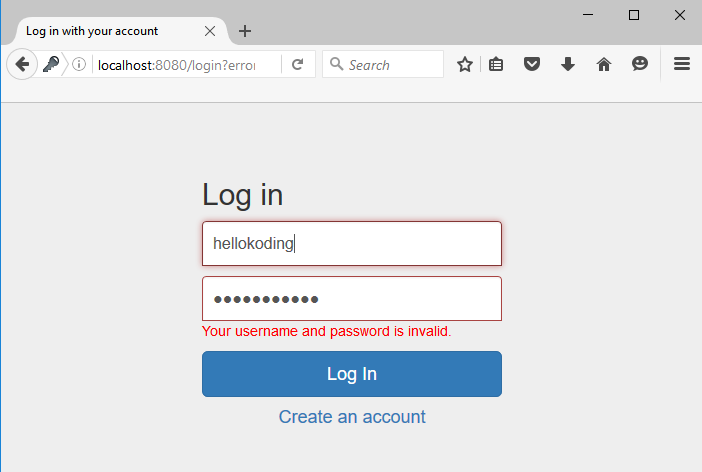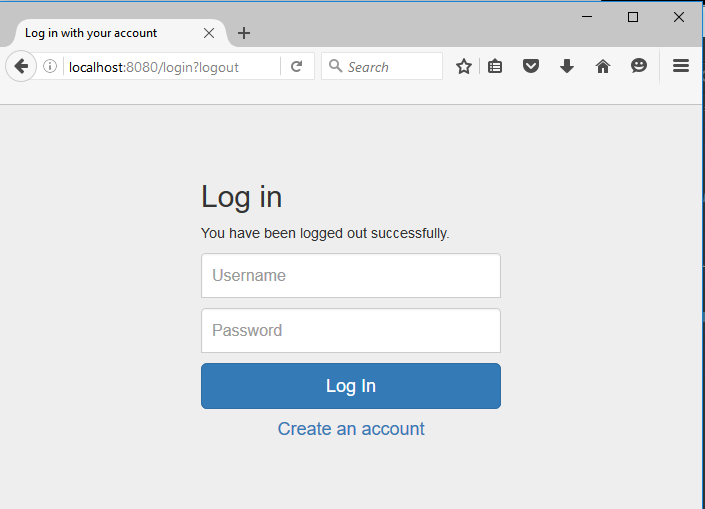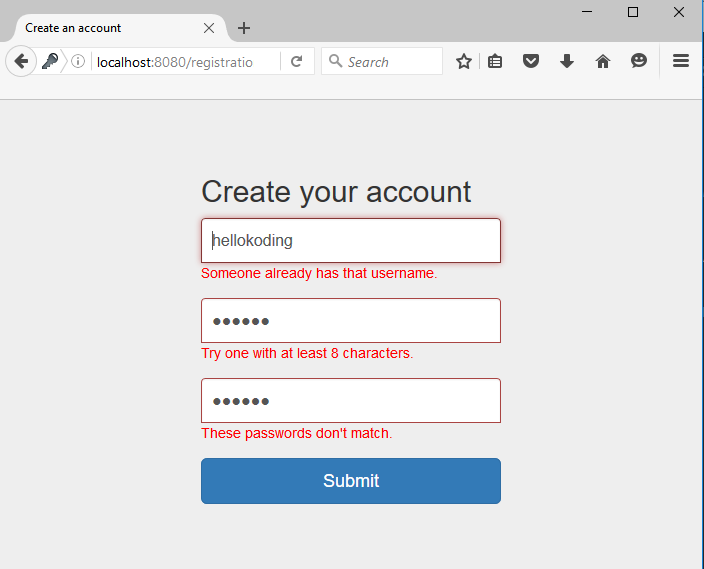This post walks you through the process of creating a simple Registration and Login Example with Spring Boot, Spring Security, Spring Data JPA and HSQL.
If you are new to Spring Boot or Spring Data JPA, it would be best to work your way through below before starting this example: - Spring Boot Hello World Example with JSP - JPA Many-To-Many Relationship Mapping Example with Spring Boot, HSQL
What you’ll build
Log in
Log out
Register account
Welcome
What you’ll need
- JDK 1.7 or later
- Maven 3 or later
Stack
- Spring Security
- Spring Boot
- Spring Data JPA
- JSP
Project structure
├── src
│ └── main
│ ├── java
│ │ └── com
│ │ └── hellokoding
│ │ └── auth
│ │ ├── model
│ │ │ ├── Role.java
│ │ │ └── User.java
│ │ ├── repository
│ │ │ ├── RoleRepository.java
│ │ │ └── UserRepository.java
│ │ ├── service
│ │ │ ├── SecurityServiceImpl.java
│ │ │ ├── SecurityService.java
│ │ │ ├── UserDetailsServiceImpl.java
│ │ │ ├── UserServiceImpl.java
│ │ │ └── UserService.java
│ │ ├── validator
│ │ │ └── UserValidator.java
│ │ ├── web
│ │ │ └── UserController.java
│ │ ├── WebApplication.java
│ │ └── WebSecurityConfig.java
│ ├── resources
│ │ ├── application.properties
│ │ └── validation.properties
│ └── webapp
│ ├── resources
│ │ ├── css
│ │ │ ├── bootstrap.min.css
│ │ │ └── common.css
│ │ └── js
│ │ └── bootstrap.min.js
│ ├── login.jsp
│ ├── registration.jsp
│ └── welcome.jsp
└── pom.xml
Project dependencies
<?xml version="1.0" encoding="UTF-8"?>
<project xmlns="http://maven.apache.org/POM/4.0.0" xmlns:xsi="http://www.w3.org/2001/XMLSchema-instance" xsi:schemaLocation="http://maven.apache.org/POM/4.0.0 http://maven.apache.org/xsd/maven-4.0.0.xsd">
<modelVersion>4.0.0</modelVersion>
<artifactId>auth</artifactId>
<name>auth</name>
<description>auth</description>
<packaging>war</packaging>
<parent>
<groupId>org.springframework.boot</groupId>
<artifactId>spring-boot-starter-parent</artifactId>
<version>1.3.5.RELEASE</version>
</parent>
<properties>
<project.build.sourceEncoding>UTF-8</project.build.sourceEncoding>
<java.version>1.7</java.version>
</properties>
<dependencies>
<dependency>
<groupId>org.springframework.boot</groupId>
<artifactId>spring-boot-starter-web</artifactId>
</dependency>
<dependency>
<groupId>org.springframework.boot</groupId>
<artifactId>spring-boot-starter-data-jpa</artifactId>
</dependency>
<dependency>
<groupId>org.springframework.boot</groupId>
<artifactId>spring-boot-starter-security</artifactId>
</dependency>
<dependency>
<groupId>org.hsqldb</groupId>
<artifactId>hsqldb</artifactId>
<scope>runtime</scope>
</dependency>
<dependency>
<groupId>org.springframework.boot</groupId>
<artifactId>spring-boot-starter-tomcat</artifactId>
<scope>provided</scope>
</dependency>
<dependency>
<groupId>org.apache.tomcat.embed</groupId>
<artifactId>tomcat-embed-jasper</artifactId>
<scope>provided</scope>
</dependency>
<dependency>
<groupId>javax.servlet</groupId>
<artifactId>jstl</artifactId>
</dependency>
</dependencies>
<build>
<plugins>
<plugin>
<groupId>org.springframework.boot</groupId>
<artifactId>spring-boot-maven-plugin</artifactId>
</plugin>
</plugins>
</build>
</project>Define JPA Entities
JPA Entity is defined with @Entity annotation, represent a table in your database.
src/main/java/com/hellokoding/auth/model/User.java
package com.hellokoding.auth.model;
import javax.persistence.*;
import java.util.Set;
@Entity
@Table(name = "user")
public class User {
private Long id;
private String username;
private String password;
private String passwordConfirm;
private Set<Role> roles;
@Id
@GeneratedValue(strategy = GenerationType.AUTO)
public Long getId() {
return id;
}
public void setId(Long id) {
this.id = id;
}
public String getUsername() {
return username;
}
public void setUsername(String username) {
this.username = username;
}
public String getPassword() {
return password;
}
public void setPassword(String password) {
this.password = password;
}
@Transient
public String getPasswordConfirm() {
return passwordConfirm;
}
public void setPasswordConfirm(String passwordConfirm) {
this.passwordConfirm = passwordConfirm;
}
@ManyToMany
@JoinTable(name = "user_role", joinColumns = @JoinColumn(name = "user_id"), inverseJoinColumns = @JoinColumn(name = "role_id"))
public Set<Role> getRoles() {
return roles;
}
public void setRoles(Set<Role> roles) {
this.roles = roles;
}
}
src/main/java/com/hellokoding/auth/model/Role.java
package com.hellokoding.auth.model;
import javax.persistence.*;
import java.util.Set;
@Entity
@Table(name = "role")
public class Role {
private Long id;
private String name;
private Set<User> users;
@Id
@GeneratedValue(strategy = GenerationType.AUTO)
public Long getId() {
return id;
}
public void setId(Long id) {
this.id = id;
}
public String getName() {
return name;
}
public void setName(String name) {
this.name = name;
}
@ManyToMany(mappedBy = "roles")
public Set<User> getUsers() {
return users;
}
public void setUsers(Set<User> users) {
this.users = users;
}
}
@Table maps the entity with the table. If no @Table is defined, the default value is used: the class name of the entity.
@Id declares the identifier property of the entity.
@ManyToMany defines a many-to-many relationship between 2 entities. @JoinColumn indicates the entity is the owner of the relationship: the corresponding table has a column with a foreign key to the referenced table. mappedBy indicates the entity is the inverse of the relationship.
Spring Data JPA Repositories
Spring Data JPA contains some built-in Repository implemented some common functions to work with database: findOne, findAll, save,…
src/main/java/com/hellokoding/auth/repository/UserRepository.java
package com.hellokoding.auth.repository;
import com.hellokoding.auth.model.User;
import org.springframework.data.jpa.repository.JpaRepository;
public interface UserRepository extends JpaRepository<User, Long> {
User findByUsername(String username);
}
src/main/java/com/hellokoding/auth/repository/RoleRepository.java
package com.hellokoding.auth.repository;
import com.hellokoding.auth.model.Role;
import org.springframework.data.jpa.repository.JpaRepository;
public interface RoleRepository extends JpaRepository<Role, Long>{
}
Spring Security’s UserDetailsService
To implement login/authentication with Spring Security, we need to implement org.springframework.security.core.userdetails.UserDetailsServiceinterface
src/main/java/com/hellokoding/auth/service/UserDetailsServiceImpl.java
package com.hellokoding.auth.service;
import com.hellokoding.auth.model.Role;
import com.hellokoding.auth.model.User;
import com.hellokoding.auth.repository.UserRepository;
import org.springframework.beans.factory.annotation.Autowired;
import org.springframework.security.core.GrantedAuthority;
import org.springframework.security.core.authority.SimpleGrantedAuthority;
import org.springframework.security.core.userdetails.UserDetails;
import org.springframework.security.core.userdetails.UserDetailsService;
import org.springframework.security.core.userdetails.UsernameNotFoundException;
import org.springframework.stereotype.Service;
import org.springframework.transaction.annotation.Transactional;
import java.util.HashSet;
import java.util.Set;
@Service
public class UserDetailsServiceImpl implements UserDetailsService{
@Autowired
private UserRepository userRepository;
@Override
@Transactional(readOnly = true)
public UserDetails loadUserByUsername(String username) throws UsernameNotFoundException {
User user = userRepository.findByUsername(username);
Set<GrantedAuthority> grantedAuthorities = new HashSet<>();
for (Role role : user.getRoles()){
grantedAuthorities.add(new SimpleGrantedAuthority(role.getName()));
}
return new org.springframework.security.core.userdetails.User(user.getUsername(), user.getPassword(), grantedAuthorities);
}
}
Security Service
We create SecurityService to provide current loggedin user and auto login user after resgistering an account.
src/main/java/com/hellokoding/auth/service/SecurityServiceImpl.java
package com.hellokoding.auth.service;
import org.slf4j.Logger;
import org.slf4j.LoggerFactory;
import org.springframework.beans.factory.annotation.Autowired;
import org.springframework.security.authentication.AuthenticationManager;
import org.springframework.security.authentication.UsernamePasswordAuthenticationToken;
import org.springframework.security.core.context.SecurityContextHolder;
import org.springframework.security.core.userdetails.UserDetails;
import org.springframework.security.core.userdetails.UserDetailsService;
import org.springframework.stereotype.Service;
@Service
public class SecurityServiceImpl implements SecurityService{
@Autowired
private AuthenticationManager authenticationManager;
@Autowired
private UserDetailsService userDetailsService;
private static final Logger logger = LoggerFactory.getLogger(SecurityServiceImpl.class);
@Override
public String findLoggedInUsername() {
Object userDetails = SecurityContextHolder.getContext().getAuthentication().getDetails();
if (userDetails instanceof UserDetails) {
return ((UserDetails)userDetails).getUsername();
}
return null;
}
@Override
public void autologin(String username, String password) {
UserDetails userDetails = userDetailsService.loadUserByUsername(username);
UsernamePasswordAuthenticationToken usernamePasswordAuthenticationToken = new UsernamePasswordAuthenticationToken(userDetails, password, userDetails.getAuthorities());
authenticationManager.authenticate(usernamePasswordAuthenticationToken);
if (usernamePasswordAuthenticationToken.isAuthenticated()) {
SecurityContextHolder.getContext().setAuthentication(usernamePasswordAuthenticationToken);
logger.debug(String.format("Auto login %s successfully!", username));
}
}
}
User Service
Provide service for registering account
src/main/java/com/hellokoding/auth/service/UserServiceImpl.java
package com.hellokoding.auth.service;
import com.hellokoding.auth.model.User;
import com.hellokoding.auth.repository.RoleRepository;
import com.hellokoding.auth.repository.UserRepository;
import org.springframework.beans.factory.annotation.Autowired;
import org.springframework.security.crypto.bcrypt.BCryptPasswordEncoder;
import org.springframework.stereotype.Service;
import java.util.HashSet;
@Service
public class UserServiceImpl implements UserService {
@Autowired
private UserRepository userRepository;
@Autowired
private RoleRepository roleRepository;
@Autowired
private BCryptPasswordEncoder bCryptPasswordEncoder;
@Override
public void save(User user) {
user.setPassword(bCryptPasswordEncoder.encode(user.getPassword()));
user.setRoles(new HashSet<>(roleRepository.findAll()));
userRepository.save(user);
}
@Override
public User findByUsername(String username) {
return userRepository.findByUsername(username);
}
}
Spring Validator
To provide input-data validation for /registration controller with Spring Validator, we implement org.springframework.validation.Validator. Error codes, e.g. Size.userForm.username, are defined by validation.properties
src/main/java/com/hellokoding/auth/validator/UserValidator.java
package com.hellokoding.auth.validator;
import com.hellokoding.auth.model.User;
import com.hellokoding.auth.service.UserService;
import org.springframework.beans.factory.annotation.Autowired;
import org.springframework.stereotype.Component;
import org.springframework.validation.Errors;
import org.springframework.validation.ValidationUtils;
import org.springframework.validation.Validator;
@Component
public class UserValidator implements Validator {
@Autowired
private UserService userService;
@Override
public boolean supports(Class<?> aClass) {
return User.class.equals(aClass);
}
@Override
public void validate(Object o, Errors errors) {
User user = (User) o;
ValidationUtils.rejectIfEmptyOrWhitespace(errors, "username", "NotEmpty");
if (user.getUsername().length() < 6 || user.getUsername().length() > 32) {
errors.rejectValue("username", "Size.userForm.username");
}
if (userService.findByUsername(user.getUsername()) != null) {
errors.rejectValue("username", "Duplicate.userForm.username");
}
ValidationUtils.rejectIfEmptyOrWhitespace(errors, "password", "NotEmpty");
if (user.getPassword().length() < 8 || user.getPassword().length() > 32) {
errors.rejectValue("password", "Size.userForm.password");
}
if (!user.getPasswordConfirm().equals(user.getPassword())) {
errors.rejectValue("passwordConfirm", "Diff.userForm.passwordConfirm");
}
}
}
Controllers
/login POST controller is provided by Spring Security
src/main/java/com/hellokoding/auth/web/UserController.java
package com.hellokoding.auth.web;
import com.hellokoding.auth.model.User;
import com.hellokoding.auth.service.SecurityService;
import com.hellokoding.auth.service.UserService;
import com.hellokoding.auth.validator.UserValidator;
import org.springframework.beans.factory.annotation.Autowired;
import org.springframework.stereotype.Controller;
import org.springframework.ui.Model;
import org.springframework.validation.BindingResult;
import org.springframework.web.bind.annotation.ModelAttribute;
import org.springframework.web.bind.annotation.RequestMapping;
import org.springframework.web.bind.annotation.RequestMethod;
@Controller
public class UserController {
@Autowired
private UserService userService;
@Autowired
private SecurityService securityService;
@Autowired
private UserValidator userValidator;
@RequestMapping(value = "/registration", method = RequestMethod.GET)
public String registration(Model model) {
model.addAttribute("userForm", new User());
return "registration";
}
@RequestMapping(value = "/registration", method = RequestMethod.POST)
public String registration(@ModelAttribute("userForm") User userForm, BindingResult bindingResult, Model model) {
userValidator.validate(userForm, bindingResult);
if (bindingResult.hasErrors()) {
return "registration";
}
userService.save(userForm);
securityService.autologin(userForm.getUsername(), userForm.getPasswordConfirm());
return "redirect:/welcome";
}
@RequestMapping(value = "/login", method = RequestMethod.GET)
public String login(Model model, String error, String logout) {
if (error != null)
model.addAttribute("error", "Your username and password is invalid.");
if (logout != null)
model.addAttribute("message", "You have been logged out successfully.");
return "login";
}
@RequestMapping(value = {"/", "/welcome"}, method = RequestMethod.GET)
public String welcome(Model model) {
return "welcome";
}
}
Properties
src/main/resources/application.properties
spring.mvc.view.prefix: /
spring.mvc.view.suffix: .jsp
spring.jpa.hibernate.ddl-auto=create
spring.jpa.show-sql=true
spring.messages.basename=validationsrc/main/resources/validation.properties
NotEmpty=This field is required.
Size.userForm.username=Please use between 6 and 32 characters.
Duplicate.userForm.username=Someone already has that username.
Size.userForm.password=Try one with at least 8 characters.
Diff.userForm.passwordConfirm=These passwords don't match.Web Security Configuration
src/main/java/com/hellokoding/auth/WebSecurityConfig.java
package com.hellokoding.auth;
import org.springframework.beans.factory.annotation.Autowired;
import org.springframework.context.annotation.Bean;
import org.springframework.context.annotation.Configuration;
import org.springframework.security.config.annotation.authentication.builders.AuthenticationManagerBuilder;
import org.springframework.security.config.annotation.web.builders.HttpSecurity;
import org.springframework.security.config.annotation.web.configuration.EnableWebSecurity;
import org.springframework.security.config.annotation.web.configuration.WebSecurityConfigurerAdapter;
import org.springframework.security.core.userdetails.UserDetailsService;
import org.springframework.security.crypto.bcrypt.BCryptPasswordEncoder;
@Configuration
@EnableWebSecurity
public class WebSecurityConfig extends WebSecurityConfigurerAdapter {
@Autowired
private UserDetailsService userDetailsService;
@Bean
public BCryptPasswordEncoder bCryptPasswordEncoder() {
return new BCryptPasswordEncoder();
}
@Override
protected void configure(HttpSecurity http) throws Exception {
http
.authorizeRequests()
.antMatchers("/resources/**", "/registration").permitAll()
.anyRequest().authenticated()
.and()
.formLogin()
.loginPage("/login")
.permitAll()
.and()
.logout()
.permitAll();
}
@Autowired
public void configureGlobal(AuthenticationManagerBuilder auth) throws Exception {
auth.userDetailsService(userDetailsService).passwordEncoder(bCryptPasswordEncoder());
}
}Application Configuration
src/main/java/com/hellokoding/auth/WebApplication.java
package com.hellokoding.auth;
import org.springframework.boot.SpringApplication;
import org.springframework.boot.autoconfigure.SpringBootApplication;
import org.springframework.boot.builder.SpringApplicationBuilder;
import org.springframework.boot.context.web.SpringBootServletInitializer;
@SpringBootApplication
public class WebApplication extends SpringBootServletInitializer {
@Override
protected SpringApplicationBuilder configure(SpringApplicationBuilder application) {
return application.sources(WebApplication.class);
}
public static void main(String[] args) throws Exception {
SpringApplication.run(WebApplication.class, args);
}
}
Run
You can run the application using mvn clean spring-boot:run and visit to http://localhost:8080
Source code
git@github.com:hellokoding/registration-login-spring-hsql.git
https://github.com/hellokoding/registration-login-spring-hsql
Registration and Login Example Brothers: - Registration and Login Example with Spring Security, Spring Data JPA, Spring Boot - Registration and Login Example with Spring MVC 4, Spring Security, Spring Data JPA, XML Configuration, Maven, JSP and MySQL




